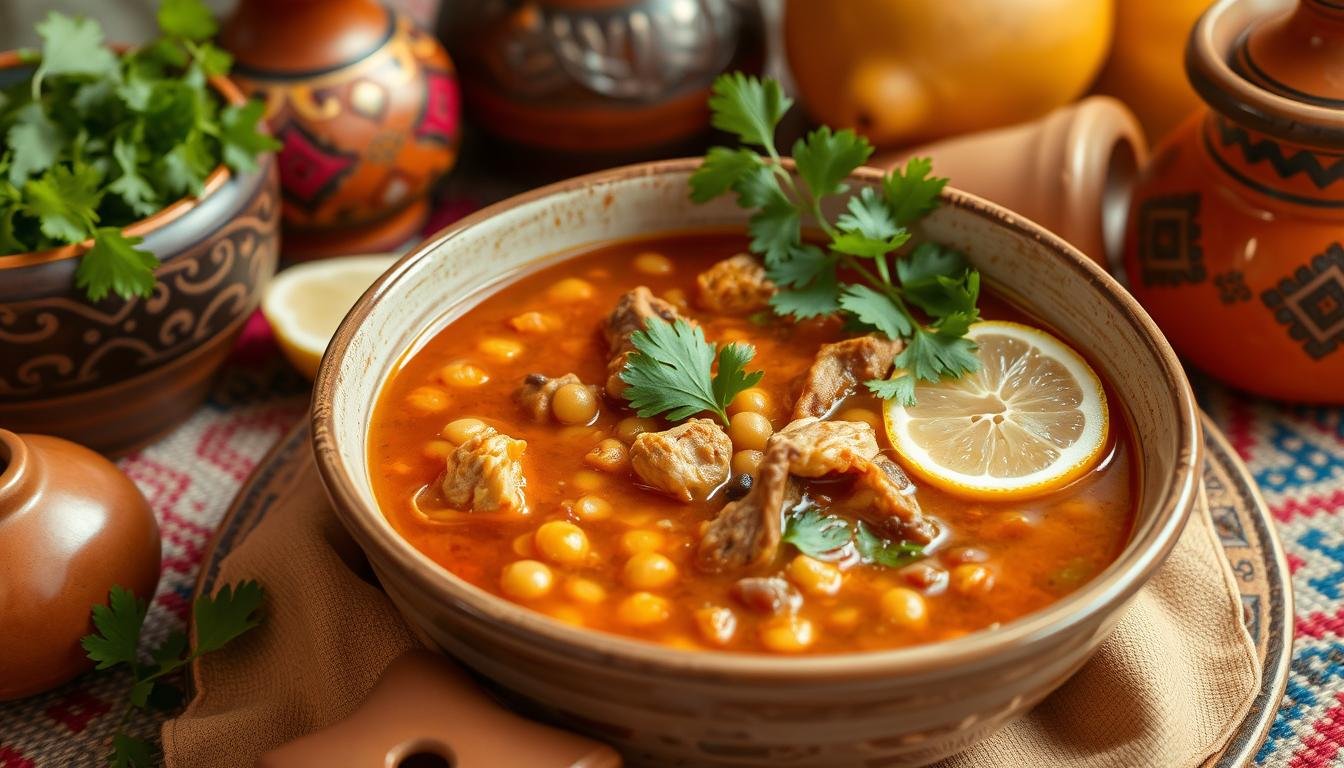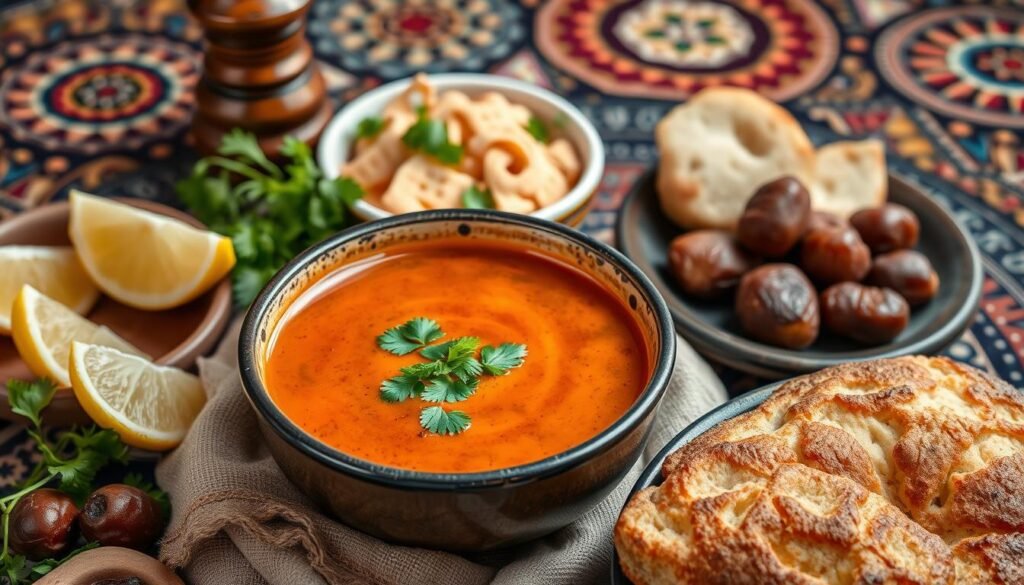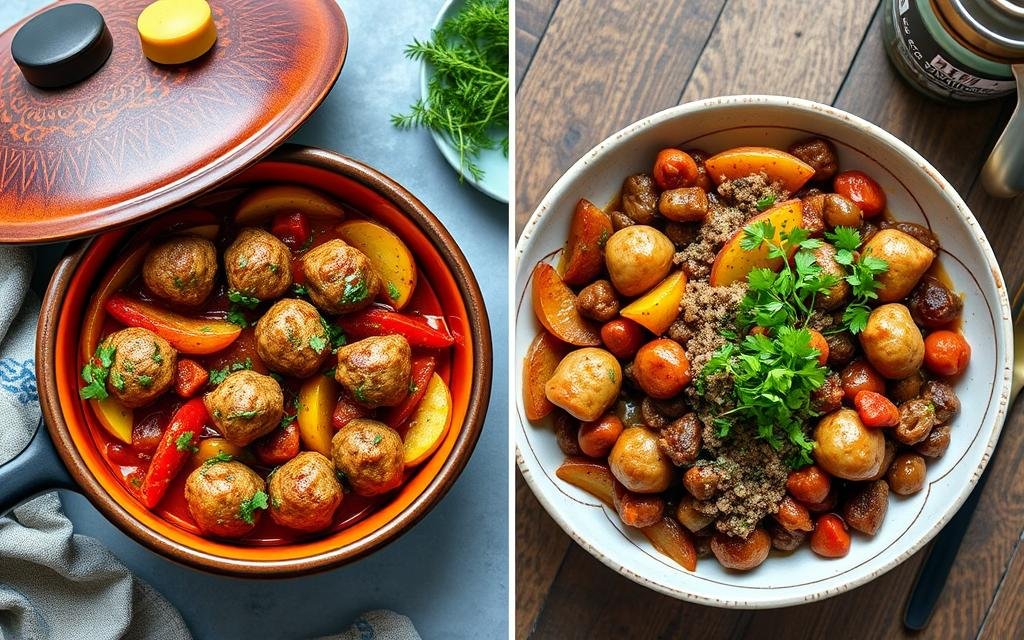
Moroccan Harira: a rich and nutritious soup
- Soups
- December 22, 2024
- 2 Comments
- 447
As the sun sets, the smell of spices and meat fills the air. It’s the start of Ramadan for many Moroccans. Harira, a hearty soup, is at the heart of their tradition. It’s packed with protein and has been a family favorite for ages.
Harira’s flavors are deep and complex. They warm both the body and soul. This makes it a comfort food loved around the world.
Key Takeaways
- Moroccan Harira is a traditional, nutritious soup with origins in North Africa.
- It’s a staple dish during the holy month of Ramadan, but enjoyed year-round.
- The soup typically contains lentils, chickpeas, tomatoes, and meat, seasoned with aromatic spices.
- Harira is known for its rich, comforting flavors and ability to nourish both body and soul.
- This flavorful soup has gained popularity globally as a delicious representation of Moroccan cuisine.
The Cultural Significance of Moroccan Harira
Moroccan Harira is more than a tasty Iftar meal. It’s deeply rooted in the country’s culture. This traditional soup has been loved for centuries, especially in Ramadan.
Traditional Role During Ramadan
Harira is key during Ramadan’s Iftar. It’s the first thing eaten, offering a nourishing start. Sharing Harira is a special tradition that unites families and communities.
Family Gatherings and Special Occasions
Harira is also a favorite at Moroccan family recipes and celebrations. It’s enjoyed at both small family dinners and big events. This soup strengthens family bonds and keeps traditions alive.
Regional Variations Across Morocco
Harira recipes vary across Morocco’s regional cuisine. Coastal areas add fish, while inland uses more meat. These differences show the unique cultural and ingredient influences on this iconic dish.
“Harira is not just a soup – it’s a tapestry of Moroccan history and culture, woven together with love and tradition.”
Essential Ingredients That Make Harira Special
Moroccan harira is a rich and flavorful soup. It’s made with lentils and chickpeas for a hearty texture and nutrition. Tomatoes add a touch of acidity, and lamb or beef provide protein.
Fresh herbs like cilantro and celery give the broth a refreshing aroma. A dash of turmeric and cinnamon spices add warmth. These ingredients blend together, making Moroccan harira special.
“The secret to an authentic Moroccan harira lies in the balance of its ingredients – from the earthy lentils to the aromatic herbs and spices that lend it depth and complexity.”
Harira can be simmered slowly or cooked quickly. Each spoonful is a journey through Morocco’s rich culinary traditions. The mix of wholesome ingredients and flavors makes it a delight for the senses.
| Key Ingredient | Contribution to Harira |
|---|---|
| Lentils | Provide a hearty, protein-rich base |
| Chickpeas | Add texture and further nutritional value |
| Tomatoes | Lend acidity and a touch of sweetness |
| Lamb or Beef | Offer a satisfying protein source |
| Cilantro | Impart a refreshing, herbal aroma |
| Celery | Provide a subtle, earthy note |
| Turmeric | Contribute a warm, golden hue and subtle spice |
| Cinnamon | Lend a touch of sweetness and depth |
Step-by-Step Guide to Making Authentic Moroccan Harira
Discover the secrets of homemade Harira, a beloved Moroccan soup. It warms the soul. Learn how to make this flavorful dish, filled with the rich traditions of Moroccan cooking.
Preparing the Base
Start by sautéing diced onions and celery in a large pot with olive oil. Add aromatic spices like cumin, coriander, and cinnamon. Let these flavors mix, creating a fragrant base for your Harira.
Adding Proteins and Legumes
- Add your preferred protein, such as lamb, beef, or chicken, and cook until browned.
- Include chickpeas and lentils for depth and substance in your soup.
- Use water or broth to deglaze the pot, scraping up tasty bits from the bottom.
Final Seasoning and Garnishing
As the soup cooks, season it to taste with salt and pepper. Add chopped tomatoes, fresh parsley, and cilantro for a vibrant finish. These herbs will enhance your homemade Harira’s flavor.
Follow these steps to make an authentic Moroccan Harira. It will take you to the lively markets of Marrakech.
Health Benefits and Nutritional Value
Moroccan harira is more than just a tasty soup; it’s a nutritional powerhouse. It’s packed with proteins and essential nutrients, making it a complete and fulfilling meal.
The soup’s protein comes from meat and legumes. This mix gives you energy and helps build and repair muscles. It also has fiber from lentils and chickpeas, which is good for your digestion and keeps you full.
But there’s more to harira than just proteins and fiber. It’s full of vitamins and minerals from its vegetables, herbs, and spices. Tomatoes add vitamin C, and spinach boosts iron, making the soup a well-rounded meal.
“Harira is not just a delicious soup; it’s a nourishing and satisfying way to fuel your body.”
If you want to eat more protein, fiber, or just a healthy meal, Moroccan harira is perfect. Try this protein-rich soup and see how it makes you feel balanced and nourished.

Common Variations and Modern Adaptations
The classic Moroccan Harira soup has evolved over time. Creative cooks worldwide have introduced new variations and modern twists. These changes cater to different diets and cooking styles. From plant-based Harira to quick-cook methods using instant pot recipes, this dish has become a global favorite.
Vegetarian and Vegan Options
Looking for a meat-free option? The traditional Harira can be turned into a tasty vegetarian or vegan soup. By using legumes like chickpeas, lentils, or a mix of beans, it keeps its richness and flavor.
Quick-Cook Methods
Busy lives call for quick cooking solutions. Modern kitchen appliances, like instant pots, make Harira fast and flavorful. You can enjoy this aromatic soup in just minutes, thanks to these quick-cook methods.
International Fusion Versions
Culinary innovators have mixed Moroccan Harira with global flavors. This results in exciting dishes that blend different cuisines. From Asian touches to Latin American spices, these versions show Harira’s versatility and ability to bridge cultural gaps.
| Variation | Description | Key Ingredients |
|---|---|---|
| Vegetarian Harira | A meat-free version of the classic Moroccan soup | Chickpeas, lentils, vegetables |
| Instant Pot Harira | A quick-cook method using a pressure cooker | Beef or lamb, broth, spices |
| Fusion Harira | Harira with international flavors and ingredients | Varies based on fusion cuisine |
Whether you’re into plant-based options, quick instant pot recipes, or global cuisine fusion, Moroccan Harira has something for everyone. Its rich history, amazing flavors, and endless variations make it a favorite among food lovers worldwide.
Serving Suggestions and Accompaniments
Moroccan harira is a hearty soup, often served with Moroccan bread and dates. The bread is great for dipping into the broth. The dates add a sweet contrast.
In Ramadan, harira is paired with chebakia, a honey-coated cookie. This combo makes the Ramadan table unforgettable. It nourishes both body and soul.
Some people add hard-boiled eggs or a squeeze of lemon juice. These extras enhance the flavor and texture. Harira’s versatility lets it pair well with many foods.
| Accompaniment | Description | Flavor Profile |
|---|---|---|
| Moroccan Bread | Warm, fluffy bread for dipping | Starch, absorbs broth |
| Dates | Sweet, natural fruit | Natural sweetness, balances savory |
| Chebakia | Honey-coated sesame cookie | Sweet, nutty, perfect for Ramadan |
| Hard-Boiled Eggs | Protein-rich addition | Creamy texture, mild flavor |
| Lemon Juice | Acidic garnish | Bright, tangy notes |

Choosing the right accompaniments for Moroccan harira makes the meal special. It honors Morocco’s rich culinary traditions.
Tips for Perfect Texture and Consistency
Getting the right texture and consistency is key for a great Moroccan Harira soup. Whether you’re an expert chef or a home cook, learning to thicken your soup and keep its signature Harira consistency is important. Here, we’ll share practical tips and solutions to help you achieve a balanced texture in your Harira.
Troubleshooting Common Issues
One common problem is when the Harira becomes too thin or too thick. If it’s too watery, add a flour or egg mixture to thicken it. Whisk in a tablespoon of flour or beaten eggs, then simmer until it’s right.
If the Harira gets too thick, add more broth or water to thin it out. This will help you get the perfect consistency.
Another issue is when the ingredients separate from the broth. Stir the soup well and simmer it longer. This will help the flavors blend together smoothly.
Storage and Reheating Guidelines
Storing leftover Harira properly is important to keep it delicious. Cool it down completely before putting it in an airtight container. This prevents bacteria and keeps the flavor and texture good.
To reheat, warm it gently on the stovetop, stirring often. Avoid microwaving to prevent uneven heating and texture.
| Soup Thickening Technique | When to Use | Approximate Thickening Ratio |
|---|---|---|
| Flour Mixture | For a thicker, stew-like consistency | 1 tbsp flour per 1 cup of broth |
| Egg Mixture | For a creamy, velvety texture | 1 egg per 2 cups of broth |
| Simmering | To reduce and concentrate the flavors | Simmer for 10-15 minutes |
By using these tips and techniques, you’ll get the perfect Harira consistency. This will impress your guests and satisfy your taste buds. Remember, mastering Moroccan Harira is about understanding soup thickening techniques and leftover soup storage. Enjoy the journey and the delicious results of your cooking.
Seasonal Considerations and Ingredient Substitutions
Moroccan Harira is a rich and aromatic soup that can be adapted for any season. It’s perfect for celebrating fresh vegetables or using what you have on hand. Harira’s flavors can be adjusted to fit your taste and available ingredients.
For seasonal produce, try swapping winter squash for summer zucchini or using ripe tomatoes in warm months. You can also substitute chickpeas or lentils for traditional lamb or beef. This makes it great for vegetarians or vegans. Feel free to get creative with spice blends or try different proteins for unique Harira variations.
This beloved Moroccan dish changes with the seasons and can use many ingredients. By using seasonal produce and pantry-friendly substitutes, you can enjoy Harira all year. It’s a versatile dish that adds variety to your cooking.
| Seasonal Produce | Pantry Staples | Harira Variations |
|---|---|---|
|
|
|
“The beauty of Moroccan Harira lies in its ability to adapt to the seasons and accommodate a wide range of ingredients.”
Historical Origins of Moroccan Harira
Harira, the beloved Moroccan soup, has deep roots in the country’s rich Moroccan culinary history. It comes from the ancient Berber cuisine, a key part of Moroccan food for centuries. The soup has grown, adding Arab influences that have made it special.
Evolution Through Centuries
The story of Moroccan harira shows the country’s diverse culture. The recipe has changed over time, with each era adding something new. It combines Berber spices and Middle Eastern cooking, blending different cultures’ traditions.
Cultural Influences
Moroccan harira mirrors the country’s complex culture. It uses ingredients like lentils, chickpeas, and lamb, showing the Berber cuisine’s focus on local, healthy foods. The spices, like cumin and cinnamon, highlight the Arab influence in Moroccan cooking.
As Moroccan harira evolves, it remains a treasured part of the country’s food heritage. It connects people across generations, celebrating the many cultural influences that have shaped Moroccan culinary landscape.
Kitchen Tools and Equipment Needed
Making an authentic Moroccan harira soup requires the right tools. You’ll need a strong soup pot and a handy immersion blender. Each tool is key to getting the soup’s perfect texture and taste.
Start with a big, heavy soup pot or Dutch oven. It’s important for cooking the soup evenly. You’ll also need sharp knives for chopping the veggies.
- A spice grinder or small coffee grinder is crucial for fresh spices. It gives harira its unique aroma.
- An immersion blender makes blending the soup easy. It helps achieve a creamy texture.
- Using a traditional Moroccan tagine for serving adds a cultural touch.
With these tools, you’re ready to make a delicious Moroccan harira soup. It will take you on a taste journey to Marrakech’s lively markets.
Conclusion
Moroccan Harira is a treasured dish that shows Morocco’s rich culture. It’s a comforting soup made with essential ingredients. This recipe has been loved for many years.
Harira is perfect for those who love Moroccan food or just want a tasty meal. It’s enjoyed in many ways, from Ramadan to family gatherings. This soup is a key part of Moroccan identity, loved everywhere.
Exploring Moroccan Harira can take you on a journey through Morocco’s markets and streets. Learning to make this dish will feed your body and spark your interest in Moroccan cuisine. It’s a way to connect with a world of flavors and traditions.







2 Comments
[…] Chinese Rice Beef Ribs Recipe Made Easy Easy Homemade Lemon Curd Cheeseburger Soup Moroccan Harira: a rich and nutritious soup Fresh Avocado, Mango, and Shrimp Salad Festive Creamy White Chicken Chili in 45 minutes […]
[…] Chinese Rice Beef Ribs Recipe Made Easy Easy Homemade Lemon Curd Cheeseburger Soup Moroccan Harira: a rich and nutritious soup Fresh Avocado, Mango, and Shrimp Salad Festive Creamy White Chicken Chili in 45 minutes […]